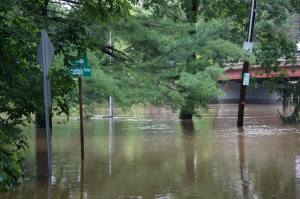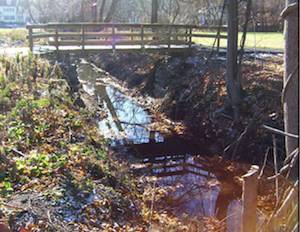Water Water Everywhere
- Thursday, 15 September 2011 10:20
- Last Updated: Thursday, 15 September 2011 10:30
- Published: Thursday, 15 September 2011 10:20
- Hits: 7387
 At least 100 people turned out on Wednesday night for a meeting that was supposed to be about the Fox Meadow Stormwater Improvement Project but drew angry Heathcote residents, frustrated with flooding at Cayuga, Canterbury, Catherine and Seneca Roads. Before they could speak, the audience heard a presentation from Dvirka and Bartilucci about the Fox Meadow Stormwater Detention Project which is already planned to alleviate flooding from George Field to the high school.
At least 100 people turned out on Wednesday night for a meeting that was supposed to be about the Fox Meadow Stormwater Improvement Project but drew angry Heathcote residents, frustrated with flooding at Cayuga, Canterbury, Catherine and Seneca Roads. Before they could speak, the audience heard a presentation from Dvirka and Bartilucci about the Fox Meadow Stormwater Detention Project which is already planned to alleviate flooding from George Field to the high school.
Half of the funding for this $3.1 million project will be funded with a grant from Westchester County. About 80% of the planning is complete and it is expected to go out for bid in December, 2011.
Rob Digiorgio of Dvirka and Bartilucci presented the elaborate plan which includes the use of large dry retention basins and rain gardens to control the water flow. Along the route from George Field to the high school, catch basins will be added, silt will be removed and the Village may even purchase a plot of land on Murray Hill Road to build an additional detention pond.
The area around George Field Park will become one of the largest wetlands areas in Westchester County. Wetlands will be rehabilitated, invasive plants will be removed and replaced with native wetland plants. In total the area will include 40,000 square feet of wetlands featuring a dry pond that can hold seven acres of water at a depth of one to three feet. This dry pond or rain garden will retain water in storms and flash floods and drain within 48 – 72 hours after a rainfall by releasing water down stream in a controlled fashion. A walkway traversing the field will be built through the wetlands. A grassy swale will be constructed along Greendale Road to direct the flow into the pond.
rehabilitated, invasive plants will be removed and replaced with native wetland plants. In total the area will include 40,000 square feet of wetlands featuring a dry pond that can hold seven acres of water at a depth of one to three feet. This dry pond or rain garden will retain water in storms and flash floods and drain within 48 – 72 hours after a rainfall by releasing water down stream in a controlled fashion. A walkway traversing the field will be built through the wetlands. A grassy swale will be constructed along Greendale Road to direct the flow into the pond.
As the watercourse continues it will flow down via backyards on Cambridge Road, an area that has been prone to chronic flooding. Here, with the cooperation of 8-10 residents who live along Cambridge, the pipe will be cleaned, and catch basins and positive drains will be installed.
From there the water flows to Cooper Green on the Post Road across the street from the Scarsdale Police Station. At Cooper Green, a 2,900 square foot detention pond and rain garden will be built, bordered by a pervious walking path.
The watercourse then proceeds into an open channel that travels along the Post Road from Fenimore Road to Murray Hill, where there is a confluence of water. Again with the cooperation of the homeowner, vegetation and silt will be cleared from that watercourse. The Village is considering purchasing land at the corner of Murray Hill and Post to retain water, but this is not part of this project.
Ultimately, the water flows from Murray Hill, to Harcourt Woods, emptying into the stream at Scarsdale High School, another trouble spot. In order to alleviate flooding of the gravel lot at the school, engineers plan to use the soil removed from George Field Park to raise the height of the high school parking lot by two inches. Moving this soil, rather than disposing of it will save the Village $300,000.
Engineers project that this work will reduce peak flows at George Field by 70% and peak flows at Cooper Green by 58%. Downstream, Murray Hill will benefit from delayed water flows. Plans call for the planting of 60-80 trees, 500 shrubs and 2,500 perennials.
The benefits of the project are as follows:
- Reduces flooding in sustained events and flash storms
- Eliminates invasive species and deteriorated trees and vegetation
- Introduces constructed wetlands to George Field Park and a rain garden to Cooper Green
- Improves water quality
Bidding is scheduled for December 2011, with contracts awarded in February, 2012. The Village expects work to begin in March or April 2012 and be completed by December, 2012.
Greenacres residents who live in the flood plane have been waiting years for this project to come to fruition. They were active in the Greenacres Association and brought their concerns directly to Village hall, when flooding of the watercourse spilled onto Windmill Circle, Greendale Road, George Field and then downstream to Cambridge Road where resident’s homes were deluged. Even though the project will not be completed for another year and a half, some expressed their gratitude while others still had questions.
Warren Breakstone of Cambridge Road joked, “I always wanted a house on the water!” He asked if the work on Cambridge Road could start earlier and cautioned that even with the new system regular maintenance will need to be done.
A Greendale Road resident told Trustees that during rainfalls raw sewage backs up onto her property, Greendale Road and George Field. She asked how this project could correct the sewage problem, saying it wasn’t safe for children or animals to walk through it. She said, “I feel like I live in a third world country.”
Steve Salzinger of Greendale Road told the trustees that he has a duck pond in front of his house when it rains and that his neighbor’s car was totaled when water climbed halfway up their garage. He wanted assurance that this project would not raise the water level on his lawn.
He also noted that a large detention basin that was built to accommodate water runoff from the new homes at Windmill Acres is always empty. In fact, he said, the water runs around it. Why was this basin dry when there was so much flooding below?
Completing the conversation Trustee Steves said, “though this will not solve everything,” he would meet with his colleagues and recommend they move forward.
After almost two hours, the conversation turned to flooding of the Sheldrake watershed and the consultant presented several slides showing a 2009 analysis of the area. The area was broken down into five basins including Garden, Cushman and Sheldrake Roads, Fenway Golf Course, Cayuga Pond and three ponds behind Murray Hill Road. The watershed ends by the Scarsdale Medical Group. Piping runs through residential areas and Seneca, Cayuga and Catherine Roads have been designated as FEMA flood zones.
The engineer suggested three projects to alleviate flooding including:
- Improve culverts on Sheldrake, Cushman and Garden Roads and increase pond capacity at Fenway
- At Murray Hill, de-silt three ponds at Fenway Golf Club, clean the watercourse to Cayuga Pond and add timed control release mechanisms
- In the Cayuga Pond area he recommended improvements to water flow, cleaning open channels, de-silting and the elimination of hairpin turns along the watercourse. Cayuga Pond should be de-silted and the outlet should be controlled.
The residents on hand were clearly frustrated with the Village’s failure to react to known flooding issues which peaked in 2007 and during Hurricane Irene. A Cayuga Road man became emotional and combative, describing how he called the Mayor and the Village during Hurricane Irene as Cayuga Pond turned into a lake, washing over his pool and into his house. He was up all night and found his swing set underwater and fish from Cayuga Pond swimming in his pool. He urged the Village to begin work now on Cayuga Pond. Steves said the Village understood residents’ distress, but said that engineering analysis was needed before the Village could undertake a project. The resident replied, “don’t minimize this! Come and sleep over.”
Bob Reiffel of 15 Cayuga Road said that the engineer’s scheme “neglected to include the culvert under Canterbury Road” and asked why Cayuga Pond had not been fixed as the work was supposed to be done ten years ago.
A man from 14 Cayuga Road offered a lengthy analysis of the situation and claimed that the consultant’s chart did not give a full picture of the problem. Saying, “we are absorbing everyone else’s water,” he called for engineers to analyze “where the water was coming from.” He told the Trustees that he has “lived here for over 25 years and did not have a drop of water until four years ago” and that “we now have a 100 year storm every four years.”
A Seneca Road warned the Trustees that during the 2007 storm Cayuga, Oneida and Seneca Roads were flooded, endangering the lives of those who live there. Saying, “our lives are important to us,” he said there is a “sense of urgency” about correcting the problems.” Doug Ulene said, “You have an obligation to protect us. You can choose between acting or failing to act and I urge you to take the course of action.”
County Legislator Bill Ryan spoke and provided a history of the County’s history of funding flood mitigation projects. He urged residents to write to County Executive Rob Astorino to continue to offer County funds for flood relief projects.
As the three and a half hour meeting drew to a close, conversation turned toward planning a project to relieve flooding at Cayuga Pond. Residents and Trustees debated the merits of short term versus long term planning but it appeared that Village Manager Al Gatta favored initiating a short-term project at Cayuga Pond. Saying, “Cayuga Pond seems to be the heart of everything,” Gatta estimated that “we can develop a plan around that. We could do a preliminary engineering plan in 10 to 12 weeks.”